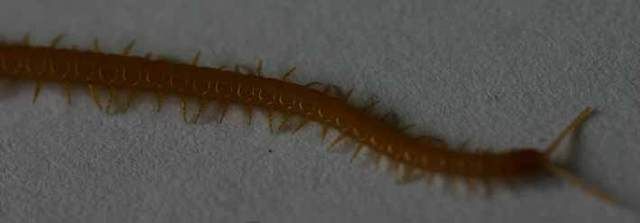OK I have been googling. I have only ever come across the common black milipede and the common dark brown centipede
"The centipede most often seen in northern Europe and the British Isles is the Brown Centipede, Lithobius forficatus, which grows up to 3 cm long and has 15 pairs of legs. It is glossy brown in colour and hides during the day under stones, leaf litter, loose bark and other such places. It occurs in both urban and rural areas, and frequently finds shelter inside garden sheds, houses and other buildings, especially among items stored in dark, damp places where there is little disturbance. Full-grown specimens can bite humans, but generally they will only do so if accidentally squeezed or handled without care. In most cases the bite has little or no after-effects."
.
Other fairly common European species include the pale red or yellowish Snake or Garden Centipedes, Geophilus and Haplophilus, which have very narrow, elongated bodies up to 7 cm long, with around 40-80 pairs of relatively short legs. They are found in soil and leaf litter, and quite often exposed when turning-over garden soil. They wriggle violently like a snake when disturbed, but are quite harmless
The centipede is a fast carnivorous creature the millipede a slow creature that feeds on rotting vegetation. This one is slow but it is in fact a centipede. The definite way to tell the difference is centipedes have 2 legs per body section millipedes have 4. Unfortunately that is where it gets more difficult, here is a list of the 58 species of centipede that have been found so far in the UK.
http://mysite.orange.co.uk/bmig/
And a basic bit of info about the differences.
Millipedes and centipedes are not insects, but are more closely related to lobsters, [crayfish and shrimp. However, unlike their marine cousins, millipedes and centipedes are land dwellers. They are most often found in moist habitats or areas of high humidity.
Description
Millipedes are often called "1000-legged" or "rain" worms. They are wormlike with rounded body segments that bear two pairs of legs on each segment. The head is rounded with short antennae. Species can vary in length from less than one to two or more inches. They are light brown to black in color.
Centipedes are often called "100-legged" worms and have one pair of legs on each of their body segments. All species of centipedes are more or less wormlike and have a flattened body with a distinct head that bears a pair of long antennae. Jaws containing poison glands are located on the first body segment immediately behind the head. Depending on the species, centipedes can vary in length from one to 12 or more inches when mature. Centipedes vary in color from light yellow to dark brown to a reddish brown.
Most species of centipedes feed on small creatures such as insects. They catch their prey with their powerful jaws and then kill the prey by injecting them with venom. Occasionally, humans may be bitten by centipedes, but the poison usually produces only a moderate reaction similar to a bee sting. People who are allergic to insect venoms and other toxins may suffer severe reactions to the venom of a centipede.
So it looks like my beastie is a centipede and probably one of the snake or garden centipedes from the families Geophilus and Haplophilus but with 58 species to choose from as often is the case the natural world of my back garden is much more complex than I had ever imagined.





 ) and many more legs. I think that most (possibly all) millipedes are herbivorous.
) and many more legs. I think that most (possibly all) millipedes are herbivorous.